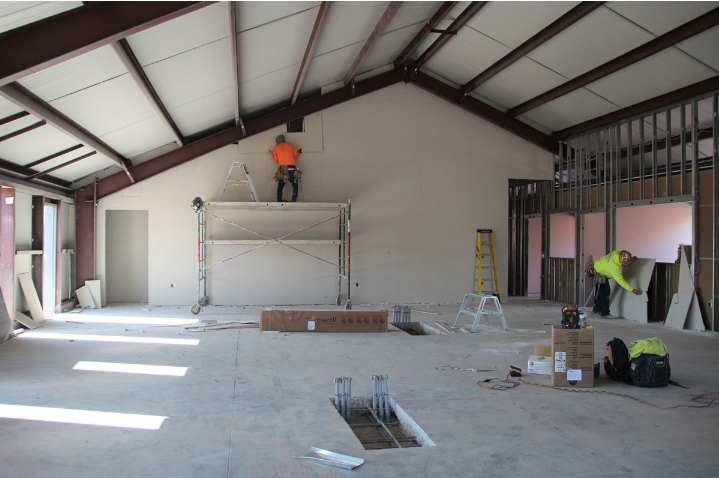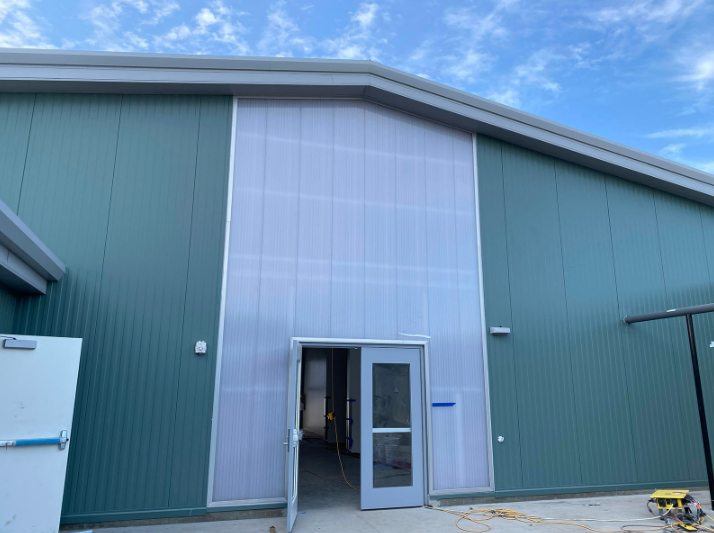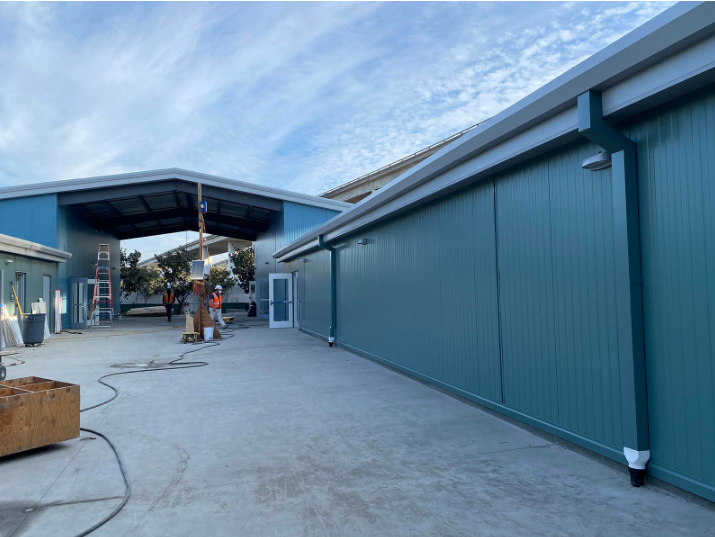Innovative Space Optimization Techniques for Metal Buildings: A Construction Guide
Metal buildings are versatile, durable, and cost-effective structures that can be used for various purposes, such as industrial, commercial, residential, and agricultural applications. However, metal buildings also face some challenges, such as limited space, thermal performance, and aesthetic appeal. Therefore, it is essential to optimize the design and construction of metal buildings to maximize their functionality, efficiency, and attractiveness.

In this article, we will explore some of the innovative space optimization techniques for metal buildings, such as:
- Choosing the right structural system and layout
- Using modular and prefabricated components
- Incorporating flexible and adaptable features
- Applying biophilic and sustainable design principles
- Utilizing smart and digital technologies
We will also provide some practical tips and examples of how to implement these techniques in your metal building projects. By following this guide, you will be able to create metal buildings that are not only functional and efficient but also comfortable and appealing.
Choosing the Right Structural System and Layout
One of the most important factors that affect the space optimization of metal buildings is the choice of the structural system and layout. The structural system refers to the arrangement and connection of the primary load-bearing elements, such as columns, beams, trusses, and braces. The layout refers to the division and organization of the interior and exterior spaces, such as rooms, corridors, doors, windows, and facades. You can contact UPVC door installers Birmingham to get an idea of what door you should get.
The structural system and layout of metal buildings should be carefully selected and designed to suit the specific needs and requirements of the project, such as:
- The size and shape of the site
- The function and purpose of the building
- The number and type of occupants and users
- The budget and schedule constraints
- The environmental and climatic conditions
- The aesthetic and architectural preferences
Some of the common structural systems and layouts for metal buildings are:
- Single-span frames: These are simple and economical structures that consist of a single row of columns and beams that span the entire width of the building. They are suitable for small and narrow buildings that do not require interior partitions or columns.
- Multi-span frames: These are more complex and flexible structures that consist of multiple rows of columns and beams that span different widths of the building. They are suitable for large and wide buildings that require interior partitions or columns to support the roof and floor loads.
- Rigid frames: These are rigid and stable structures that consist of columns and beams that are rigidly connected at the joints. They are suitable for buildings that require high strength and stiffness to resist lateral loads, such as wind and earthquake forces.
- Braced frames: These are flexible and economical structures that consist of columns and beams that are connected by diagonal braces. They are suitable for buildings that require low strength and stiffness to resist lateral loads, such as wind and earthquake forces.
- Trusses: These are lightweight and efficient structures that consist of triangular units that are composed of slender members that are connected by joints. They are suitable for buildings that require long spans and large clear heights, such as warehouses, hangars, and stadiums.
- Arches: These are curved and elegant structures that consist of arch-shaped members that are supported by columns or walls. They are suitable for buildings that require aesthetic appeal and natural lighting, such as churches, museums, and auditoriums.
The layout of metal buildings should be optimized to create functional and efficient spaces that meet the needs and expectations of the occupants and users. Some of the factors that affect the layout of metal buildings are:
- The circulation and accessibility of the spaces
- The privacy and security of the spaces
- The natural and artificial lighting of the spaces
- The ventilation and thermal comfort of the spaces
- The acoustics and noise control of the spaces
- The furniture and equipment arrangement of the spaces
The layout of metal buildings should be designed to minimize the wasted and unused spaces, such as corridors, corners, and dead ends. It should also be designed to maximize the usable and flexible spaces, such as open-plan areas, mezzanines, and lofts. Additionally, the layout of metal buildings should be designed to enhance the visual and spatial quality of the spaces, such as by creating views, focal points, and contrasts.
When it comes to optimizing the layout of metal buildings, loft conversions can be a transformative solution. By converting upper spaces into functional loft areas, you can significantly increase usable space and create versatile environments that cater to various needs. Whether you’re looking to add extra rooms, office space, or leisure areas, a well-planned loft conversion can enhance the overall functionality of your building.
To explore innovative loft conversion ideas and gain inspiration for your project, Visit Deluxe Lofts Website. They offer a range of design options and insights that can help you make the most of your metal building’s potential. By incorporating thoughtful design elements and expert advice, you can achieve a stylish and practical loft conversion that complements the building’s overall layout and maximizes its value.

Using Modular and Prefabricated Components
Another innovative space optimization technique for metal buildings is the use of modular and prefabricated components. Modular and prefabricated components are standardized and mass-produced building elements that are manufactured off-site and assembled on-site. They can include structural, architectural, mechanical, electrical, and plumbing components, such as:
- Wall panels
- Floor panels
- Roof panels
- Columns
- Beams
- Trusses
- Braces
- Doors
- Windows
- Cladding
- Insulation
- Wiring
- Piping
- Ducts
- Fixtures
- Appliances
You can contact experts such as this electrical contractor in White Plains, NY or plumbing installation services for additional guidance. For cleaning fixtures, you can consult experts that do drain cleaning in Everett, WA.
The use of modular and prefabricated components for metal buildings offers several advantages, such as:
- Reducing the construction time and cost
- Improving the construction quality and accuracy
- Enhancing the construction safety and sustainability
- Increasing the design flexibility and customization
- Simplifying the construction process and management
The use of modular and prefabricated components for metal buildings also enables the optimization of the space, such as by:
- Reducing the material waste and excess
- Minimizing the structural depth and weight
- Maximizing the structural span and height
- Eliminating the unnecessary joints and connections
- Integrating the multiple functions and systems
- Adapting to the site conditions and constraints
- Modifying to the future changes and needs
Incorporating Flexible and Adaptable Features
A further innovative space optimization technique for metal buildings is the incorporation of flexible and adaptable features. Flexible and adaptable features are building elements that can be easily changed, moved, or removed to accommodate different functions, users, or situations. They can include structural, architectural, mechanical, electrical, and plumbing features, such as:
- Movable walls
- Sliding doors
- Folding windows
- Retractable roofs
- Expandable floors
- Adjustable columns
- Removable beams
- Detachable trusses
- Replaceable braces
- Reconfigurable furniture
- Modular equipment
- Smart devices
- Sensors
- Controllers
- Actuators
The incorporation of flexible and adaptable features for metal buildings offers several benefits, such as:
- Improving the functionality and efficiency of the spaces
- Enhancing the comfort and satisfaction of the occupants and users
- Increasing the diversity and variety of the spaces
- Extending the lifespan and value of the building
- Responding to the changing needs and demands of the market
The incorporation of flexible and adaptable features for metal buildings also enables the optimization of the space, such as by:
- Creating multiple and alternative uses of the spaces
- Adjusting the size and shape of the spaces
- Controlling the environmental conditions of the spaces
- Transforming the appearance and character of the spaces
- Enabling the interaction and communication of the spaces
Applying Biophilic and Sustainable Design Principles
Another innovative space optimization technique for metal buildings is the application of biophilic and sustainable design principles. Biophilic and sustainable design principles are design approaches that aim to enhance the connection and harmony between the building and the natural environment. They can include structural, architectural, mechanical, electrical, and plumbing principles, such as:
- Using natural and renewable materials
- Reducing the energy and water consumption
- Improving the indoor air quality and daylighting
- Incorporating the natural ventilation and cooling
- Implementing the rainwater harvesting and recycling
- Integrating the green roofs and walls
- Adding the plants and vegetation
- Providing the views and access to nature
- Mimicking the natural forms and patterns
- Applying the biomimicry and biophilia concepts
The application of biophilic and sustainable design principles for metal buildings offers several advantages, such as:
- Reducing the environmental impact and footprint of the building
- Improving the health and well-being of the occupants and users
- Increasing the aesthetic and ecological value of the building
- Supporting the social and cultural identity of the community
- Contributing to the global and local sustainability goals
The application of biophilic and sustainable design principles for metal buildings also enables the optimization of the space, such as by:
- Enhancing the thermal and visual comfort of the spaces
- Increasing the natural and artificial lighting of the spaces
- Improving the ventilation and air quality of the spaces
- Reducing the noise and pollution of the spaces
- Creating a sense of place and belonging in the spaces
Utilizing Smart and Digital Technologies
A final innovative space optimization technique for metal buildings is the utilization of smart and digital technologies. Smart and digital technologies are technologies that use data, information, and communication to enhance the performance, functionality, and efficiency of the building. They can include structural, architectural, mechanical, electrical, and plumbing technologies, such as:
- Building information modeling (BIM)
- Computer-aided design (CAD)
- Parametric design and optimization
- Artificial intelligence (AI) and machine learning (ML)
- Internet of things (IoT) and cloud computing
- Augmented reality (AR) and virtual reality (VR)
- Digital fabrication and 3D printing
- Robotics and automation
- Sensors and monitors
- Cameras and scanners
- Wireless and Bluetooth
- Smartphones and tablets
- Apps and software – For businesses aiming to create seamless and high-performing iOS applications, working with a professional ios app developer sydney can ensure top-quality results tailored to the local market.
- Databases and dashboards
- Algorithms and codes
The utilization of smart and digital technologies for metal buildings offers several benefits, such as:
- Enhancing the design and construction quality and accuracy
- Reducing the design and construction time and cost
- Improving the design and construction safety and sustainability
- Increasing the

Conclusion
Metal buildings are becoming more popular and prevalent in the modern construction industry, as they offer many advantages over conventional buildings, such as versatility, durability, cost-effectiveness, and sustainability. However, metal buildings also pose some challenges, such as limited space, thermal performance, and aesthetic appeal. Therefore, it is important to optimize the design and construction of metal buildings to maximize their functionality, efficiency, and attractiveness.
In this article, we have discussed some of the innovative space optimization techniques for metal buildings, such as choosing the right structural system and layout, using modular and prefabricated components, incorporating flexible and adaptable features, applying biophilic and sustainable design principles, and utilizing smart and digital technologies. By applying these techniques, you will be able to create metal buildings that are not only functional and efficient, but also comfortable and appealing.
If you want to learn more about the benefits of choosing steel buildings for modern construction, you can check out this article: MAXIMIZING DURABILITY AND EFFICIENCY: THE TOP ADVANTAGES OF CHOOSING STEEL BUILDINGS FOR MODERN CONSTRUCTION.